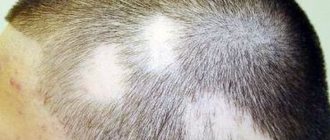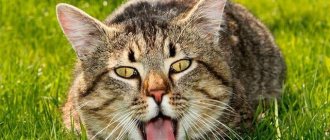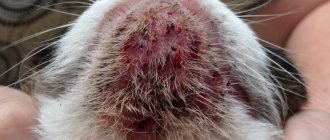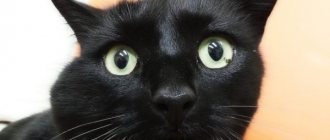The appearance of black dots that look like dirt on a cat's chin indicates the development of acne. Sometimes pathogenic bacterial microflora is involved in the process and inflammation occurs, pustules with pus are formed. To prevent the development of such pathologies, owners should be aware of measures to prevent the appearance of black spots on a cat’s chin, as well as methods of treating them.
The main causes of the disease in cats
It is quite difficult to immediately say why inflammation of the animal’s skin occurs. Therefore, it is extremely important to correctly detect the location of acne in your pet. The place where it appears will indicate the cause of the disease. Mostly in animals, blackheads appear in the area of the lips and chin. Veterinarians identify the following causes of the disease:
- Low stress resistance in the animal. After a change of environment, for example, very often there is a disruption in the functioning of the sebaceous glands.
- Insufficient hygiene, poor cleaning of the animal's chin.
- An unusual change in the functioning of the sebaceous glands, as well as in the cat’s hair follicles.
- The animal's immune system is quite weakened. Acne tends to appear at moments when the body loses all its defenses.
- If low quality plastic utensils are used for food.
These are just a few of the main causes of acne in animals, which can lead to dire consequences. The main requirement for the owner is to closely monitor the condition of his animal.
What are comedones
Comedones for cats are the same as blackheads or acne for humans. But for animals (due to the structure of their skin) this pathology is much more dangerous, since its consequences are not limited to deterioration in appearance. Comedones are clogged and inflamed sebaceous glands. In cats, acne (acne, blackheads) almost always appear in the chin area. This is their species-specific feature. In the same dogs, comedones can appear on any part of the body.
These organs secrete a special secretion (sebum), which moisturizes and lubricates the surface of the skin and coat, preventing them from drying out. In addition, the secretion of the sinuses contains many odorous and aromatic substances. When a pet rubs against objects around it, it leaves odorous marks on them, which help the animal communicate with its relatives. Due to the anatomy of cats, their sebaceous glands are directly connected to the hair follicles, which is potentially fraught with problems (we will mention this below).
The problem is that in cats with this pathology, the hair follicles often become inflamed, and the inflammation is usually purulent. Pathogenic microflora multiplies quickly, and the skin becomes severely festering. In severe and advanced cases, “harmless acne” can lead to the development of septic processes, which directly threatens the death of the pet.
How to correctly identify acne in a cat
Some types of cats have a chronic form of skin disease. When treating pathologies in animals, it is possible to completely eradicate the possibility of a secondary infection, which can aggravate the animal’s condition.
There are numerous symptoms by which you can easily detect some abnormalities in a cat. If you detect them earlier , then it is possible to treat your pet in time without consequences for its health. What you should pay attention to:
- Overflow of blood vessels on the skin.
- Small acne with a white or black surface.
- A gradual increase in size of acne and its growth on the surface of the cat's face.
- Noticeable swelling near the lips.
- Vivid inflammation of ulcers and nodes in the follicles.
- Painful itching.
- Partial baldness of a cat.
The latest symptoms indicate an advanced stage of acne. The pet tries to relieve the itching by scratching the wound for a long time, which leads to discomfort and a bloody crust. Those follicles that become damaged cannot produce hair again, so the cat begins to gradually go bald.
Predisposing factors
There are the following predisposing factors that contribute to the development of acne:
- Unbalanced, poor quality diet. The lack of vitamins A and E especially hits the skin.
- Acne is common in long-haired cats, whose owners do not carefully monitor the hygiene of their pets. The animal should be washed, bathed and combed at least from time to time.
- Dirty and unwashed feeding bowls (as we already discussed above).
- Stress.
- Poor living conditions. In particular, if a cat prefers to sleep in one place, it is necessary not only to place bedding there, but also to regularly change (wash, wash) it.
What are some skin diseases similar to acne in cats?
Before starting treatment , it is necessary to accurately determine the disease in your pet. Only a veterinarian will tell you the correct diagnosis after a thorough examination of the animal in the clinic. What appears on an animal’s face can indicate not only acne, but also other skin diseases. The symptoms of many diseases coincide, it is recommended not to draw hasty conclusions. The most similar causes in terms of symptoms:
- allergy,
- dermatophytosis condition,
- scabies,
- granuloma of the eosinophilic group,
- demodicosis reaction.
In order to completely exclude or confirm a fungal or parasitic group of skin lesions, a scraping study should be carried out. It is recommended not to jump to conclusions and make a diagnosis based only on symptoms. For an accurate diagnosis, laboratory data is required.
Diagnostics in a veterinary clinic
Going to the clinic with your pet is mandatory, since the symptoms of acne are similar in their symptoms to such dangerous diseases as sarcoptic mange (scabies), eosinophilic (linear) granuloma, demodicosis (subcutaneous mite), dermatomycosis (ringworm). The appearance of acne can also be associated with an allergic reaction.
To make an accurate diagnosis, the clinic will take a skin scraping from your pet for analysis. The biomaterial is studied for the presence of bacteria and fungi.
The results of the analysis, if they confirm acne, will allow the doctor to prescribe the correct treatment and recommend that the animal owner eliminate possible household factors that irritate the animal’s skin or make changes to its diet.
Step-by-step treatment
Treating acne in cats at home is quite simple. The main requirements are to maintain hygiene and sterilize the area with sore skin. This is what will help reduce the risk of new onsets of the disease. Any treatment must be coordinated with a veterinarian, since the animal’s condition may worsen if the diagnosis is incorrect. But if you are completely sure that your pet is experiencing discomfort due to blackheads and acne, you should take a number of actions to avoid a growing problem:
- It is recommended that you regularly shampoo your pet on the affected area, thoroughly and gently.
- Before starting the procedure, the area should be neutralized with 3% hydrogen peroxide.
- If the animal has long hair, it is necessary to shave the hair in the affected area.
- The preparations that need to be applied to the area must dissolve the keratinized part of the skin.
- The use of antibiotics to treat acne in cats occurs only in advanced cases, when black spots on the chin begin to grow.
Home treatment should always be carried out carefully and using sterile items. Fluffy pets will try to escape from your hands in every possible way, not succumbing to your intervention.
Caring for a cat during rehabilitation
High-quality cat care during the rehabilitation period accelerates the pet’s recovery process:
- As we wrote above, the pet is washed with keratolytic shampoos at least three times a week.
- The pet is fed from a clean bowl, which should be washed daily.
- You should protect your pet from hypothermia, as hypothermia stimulates the development of the inflammatory process.
- The cat's diet must be completely balanced in macro- and microelements, vitamins and fats.
- During the treatment period, the animal is given boiled sea fish three times a week as a source of polyunsaturated omega-3 fatty acids.
Is it worth it to self-medicate?
Many owners use lotions and scrubs to relieve painful itching in their pet. The use of such medications can lead to poor health. Black spots on the chin should be treated only with proven remedies. Home treatments can cause allergic acne .
Treatment should be carried out by a knowledgeable person - a veterinarian. The first signs of acne in cats appear noticeably; after they are detected, it is recommended to visit a specialist. It is he who will competently conduct laboratory tests, make a diagnosis and prescribe treatment that must be followed. Any changes must be agreed upon.
Only by the size of the rash can one determine the degree of complication of the disease. When a cat's acne is at a minimal stage, local treatment of the animal is prescribed, but if the affected skin has reached large proportions, a comprehensive series of actions is applied . When treated by a specialist or at home, you should:
- do not squeeze out existing blackheads and pimples,
- adjust the proper nutrition of your pet, while eliminating all possible allergic sources that serve as irritants,
- Treatment should be carried out until the cat has completely recovered.
It is important to remember the principles of treatment - do not abuse 'folk' remedies. The pet must undergo a course of laboratory tests in order to know the diagnosis for sure. Based on the diagnosis, it will be easier to cure the cat.
The essence of the problem
The most common place where cat acne appears is the chin. Dark dots are least likely to be seen on the tail. Fleas or other parasites leave their waste products anywhere on the animal's body. In advanced cases, the spots on the cat’s fur are localized in the following areas :
- folds on the paws;
- inner thighs;
- eyelids;
- nipples;
- jaws.
© shutterstock
Dark spots can also be found around the anus. If multiple black rashes appear on your pet's skin, you should see a veterinarian.
Effective remedies for rashes in pets
Before you begin home treatment for acne in cats, you need to decide on a list of necessary medications. The best treatment method would be healing shampoos with tar soap. It is these solutions that can provide maximum antiseptic and antiseborrheic effect. It is worth applying the mask regularly. Calendula tincture soaked in a gauze bandage will reduce the severity of the disease in a few days.
A drug for the treatment of acne in cats based on Furacilin is found in Perkutan. A similar prescription can be purchased at any veterinary pharmacy. The main requirement is that contact with the eyes is unacceptable .
When a secondary focus of infection occurs with the appearance of a bloody crust and abscess, antibiotics are used. For the speedy restoration of the skin, preparations with vitamins A and retinol-containing medications will help.
You should use cosmetics at home for treatment only as prescribed by a specialist. It is necessary to exclude all fatty types of food, replacing them with vitamin supplements.
At-risk groups
Veterinarians believe that the appearance of acne is not related to the breed, age or gender of the pet. Pathologies can be either isolated or regular, cyclical, depending on the cause of the disease.
Statistics show that castrated and sterilized animals are less susceptible to the disease, but even in this case its occurrence is not excluded.
Most often, acne appears repeatedly in cats, so it is important to completely cure the animal the first time acne appears.
In individuals with long hair, lesions may appear on the face and in the folds of the skin. The only exception is hairless cats (Sphynxes), due to greater sebum secretion than other breeds, these animals have a higher risk of acne. Careful care helps eliminate the risk of pathology.
Folk wisdom in the treatment of acne
Traditional medicine is always popular with supporters of natural treatment. Here are some recipes:
- Two tablets of ground furatsilin with three tablespoons of chamomile decoction. Store the solution in a cool place. Lubricate black spots on the cat’s chin 6-7 times a day.
- You can treat a problem in a cat with fresh pumpkin juice, rubbing the affected area several times a day.
- Mix a few tablespoons with dry herbs and cook in one liter of water. Lotions are made 4-5 times a day.
For various reasons, acne may appear on a cat's chin. Effective remedies will tell you how to treat this disease. The main point is that it is not recommended to apply lotions more than 10 times per day. Do not overdry the skin of your pet's face.
Acne and blackheads can occur at any age in a cat, regardless of breed, gender or weight. The disease is common among domestic animals.
Treatment for this type of disease is not so difficult. The basic rules are not to self-medicate, observe the basic requirements of cat hygiene and its nutrition should be rational.
Definition of disease
Acne is a multifactorial pathology in which comedones (blackheads) form on the skin of a cat’s chin. These formations occur with increased secretion of the sebaceous glands in conjunction with a disruption of the keratinization process in the stratum corneum of the epidermis.
Acne affects cats of any gender, age and breed, regardless of the conditions of detention.
There is no single cause for the appearance of blackheads in cats. Predisposing factors for their formation include non-compliance with basic rules of care and nutrition, stress, infectious and parasitic diseases.
Note! According to statistics, neutered pets practically do not get acne.
Special diet
During treatment, the veterinarian will most often immediately recommend putting the cat on a special diet, eliminating any fatty and high-calorie foods from the diet. This is done in stages:
- Refusal of dry and canned food.
- Introduction of fiber and carbohydrates into the diet, usually in the form of porridges made from oatmeal and pearl barley.
- Adding vegetable or fruit stews and purees to the daily portion of food.
- Addition of vitamin complexes (ascorbic acid, vitamin A, tocopherol). It is important to observe their correct dosage. Excess can cause allergic reactions, and deficiency can cause vitamin deficiency.











